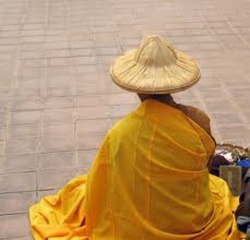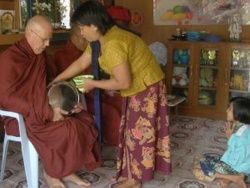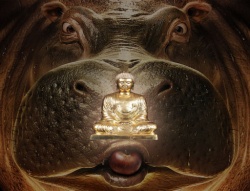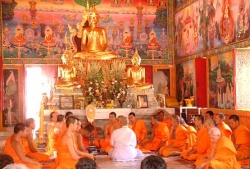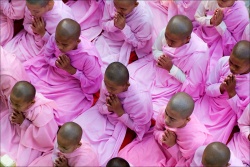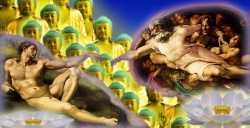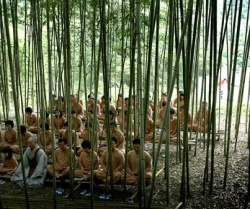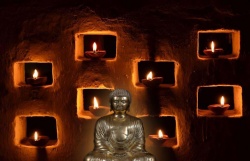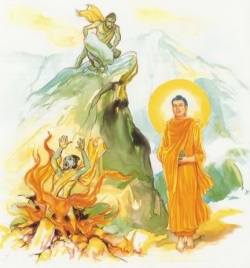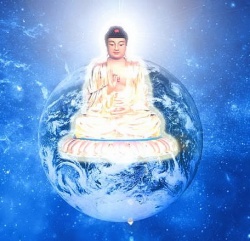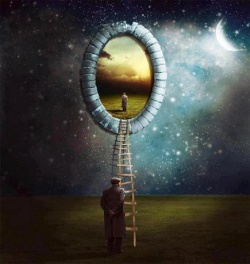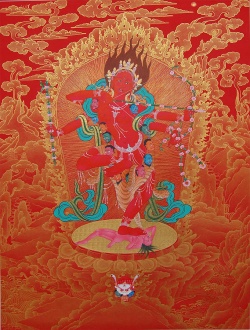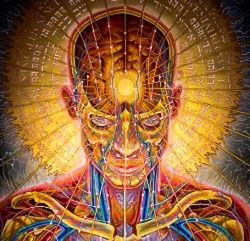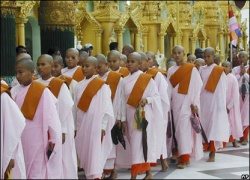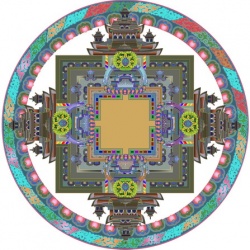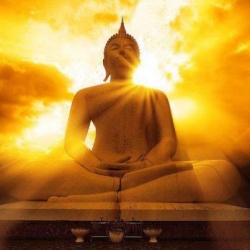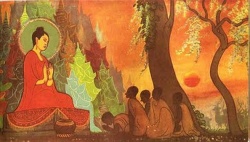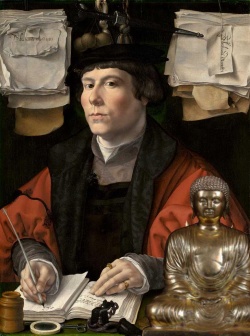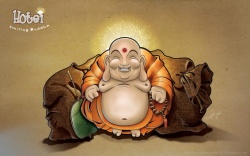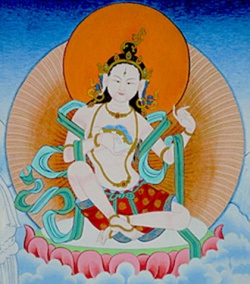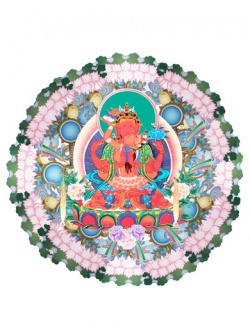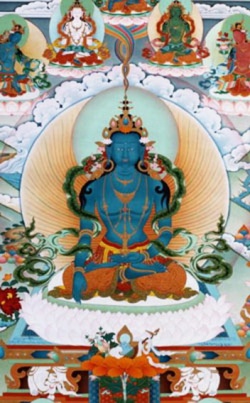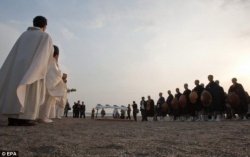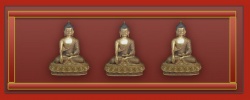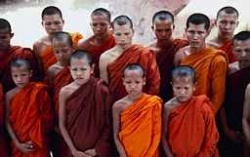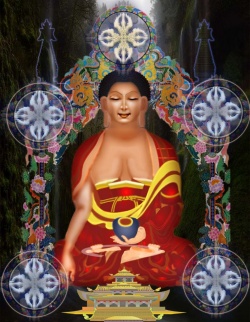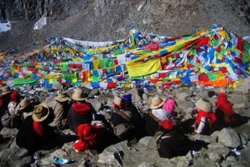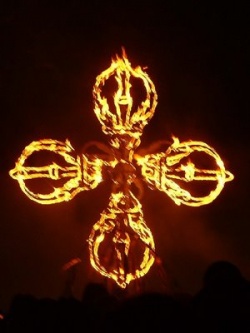Tibeto-Mongolian Astrology and Karma
Tibeto-Mongolian Astrology and Karma Alexander Berzin Munich, Germany June 13, 1996
The Benefits of Learning Astrology
In a Buddhist context, when we reaffirm our motivation at the start of a lecture, we always emphasize that our aim in listening is to learn something that can help us with our lives.
Specifically, we wish to learn not only something to help us with our own problems, but also what will enable us to be of best help to others. When we think about astrology in that context, we need to be clear as to what we can actually derive from studying and learning about it.
On one level, knowledge of astrology helps us to know what may happen in the future. Based on this knowledge, we can take preventive measures to avoid difficulties.
Dharma, after all, literally means preventive measures.
We need to be careful, however, not to become superstitious and think that everything is predetermined – that certain problems will definitely come – since that is not at all the Buddhist view of life.
Especially when we look at predictive astrology, it is very important to understand it within the context of the Buddhist teachings of karma.
On another level, learning astrology gives guidelines for better understanding ourselves so that we gain some idea of our emotional problems.
On a more general level, its features of planets, signs, and so forth, provide a certain analytical structure within which to look at our lives and our personalities.
When we want to help someone, it is not easy to gain a clear idea about what type of problem he or she may have or what the best way to communicate with the person may be.
Some knowledge of his or her horoscope and how it compares to our own is helpful for gaining an idea of how first to approach the person.
Again, we need to look at this within a Buddhist context. It is very important to avoid locking people into solid categories and thinking, "Oh, this man is a Libra and I am a Leo; I have to act in this way with him.
That woman is a Taurus, so I have to act that way." Such faulty thinking leaves no room for individuality and does not allow for flexibility.
When we have no idea of how to relate to someone, astrology can reveal the first card to play with the person. We need to approach astrology from this point of view and always put it together with the Buddhist teachings on karma and voidness.
Among the many traditions of astrology in the world, the Tibetan-Mongolian system is one of the more complex. It is much more complicated than Western astrology.
Here, we shall simply survey the subject in brief, so that we get some idea of what it contains. Mongolian astrology is a slight variant of the main Tibetan astrological system, but now in the way of an introduction, let us speak of the Tibetan-Mongolian system in general.
Then, we can turn to the relationship of astrology with karma and voidness.
That latter discussion is not specific or limited to Tibetan-Mongolian astrology; but is relevant to all systems of astrology.
The Scope of Tibetan-Mongolian Astrology
The study of Tibetan-Mongolian astrology deals with many topics.
Most people think of astrology only in terms of calculating and interpreting horoscopes; and when you train in Tibetan-Mongolian astrology, you certainly learn to do this.
Tibetan and Mongolian horoscopes, however, provide not only pictures of the personality with which someone is born – the natal chart.
They also elaborate how the person's life may unfold over the years – the progressed chart – derived in a way very different from that in Western horoscopes.
You cannot draw a horoscope if you do not have someone's birth date and the progression of their life span in the context of a calendar.
Thus, a major part of the study involves mathematics and the calculations for making the Tibetan and Mongolian calendars, which are also quite different from the Western one.
Further, you cannot make a horoscope if you do not know the precise location of the planets at the time of birth and later in life.
Another large part of the training, then, is the mathematics for calculating the Tibetan-Mongolian ephemeris, in other words, the positions of the planets each day.
A few tables of these positions are available for ready consultation, as in the West; but Tibetan and Mongolian astrologers mostly calculate everything by hand.
In conjunction with the calendar, the astrologers also make almanacs.
An almanac indicates the days and hours that are most auspicious for starting to plant the crops in the fields, for harvesting them, and other such things that are important for a society.
As is the case with Tibetan-Mongolian medicine, Tibetan-Mongolian astrology uniquely blends aspects that derive from Indian, Ancient Greek, Chinese, Central Asian, and native Bon origins.
The material divides into two major aspects: "white calculations" and "black calculations."
This nomenclature has nothing to do with good or bad, as in the terms "white" or "black" magic. White and black are abbreviations for the Tibetan names of India and China respectively.
India in Tibetan is known as "the vast land where people wear white" and China as "the vast land where people wear black."
White Calculations and Kalachakra
Many similar systems of astrology developed in India, several Hindu and one Buddhist.
The white calculations come primarily from the Indian Buddhist system, found in the Kalachakra tantra materials.
Kalachakra means "cycles of time," with three levels: external, internal, and alternative cycles.
The external cycles refer to the cycles through which the universe passes.
Because of these cycles, you can measure time externally by looking at the passages of the sun, moon, and planets around the heavens.
Buddhism defines time, after all, as a measurement of change.
Moreover, from the cycles of the patterns that the heavenly bodies make in relation to each other from their motion, we derive horoscopes.
The entire study of astronomy and astrology is associated with these external cycles.
Internally, you can also measure the passage of time by cycles in the body.
For example, you can measure time by the number of breaths that a person takes.
You can also measure it by the human life cycle of childhood, adolescence, adulthood, and old age, or a woman's menstruation cycle.
Thus, there are external and internal cycles of time; and, according to the Kalachakra teachings, they parallel each other.
When we look from a Buddhist point of view, we would say that ordinary beings have no control over these cycles.
The cycles occur by the force of karma, or impulses of energy.
The external cycles, which account for the transit charts of the daily positions of the heavenly bodies, "ripen" or result from general shared karma.
The internal cycles, which account for peoples' natal and progressed charts, ripen from each person's individual karma.
We suffer all sorts of problems because of not being in control of any of these karmic ripenings and their effects on us.
Some persons, for example, are strongly affected by their natal horoscope configurations.
They have difficulties dealing with not only their personal lives, but also with external cycles such as long winters or full moons.
Some people become a little crazy on full moons, like werewolves! People also have difficulties dealing with the internal cycles: the cycle of hormone development as they pass through puberty, the menstrual cycle, the aging process, and so on.
In Buddhism, we strive to gain liberation from these uncontrollably recurring cycles, which we call samsara, and to go on to become enlightened Buddhas so that we can be of best help to everyone.
The alternative cycles of time entail the various practices of Kalachakra meditation to gain liberation and enlightenment.
This important point reveals the basic orientation Buddhism has toward astrology. We want to gain liberation from being at the mercy of astrological features such as horoscopes.
According to Buddhism, the mental continuum or mind-stream of each individual has experienced problems with no beginning and, if we do nothing to change the situation, it will go on experiencing them forever, from one lifetime to the next.
This means that we need to liberate ourselves not only from our personal horoscopes of this lifetime; we need to liberate ourselves from all possible horoscopes of any future uncontrollably occurring rebirth. In other words, we aim to liberate ourselves from the zodiac itself.
We can see from this approach that a horoscope is not something concrete and fixed, not something dictating the way that we definitely have to be, and that we can do nothing about it.
We want to liberate ourselves from any such imagined constrictions and, to do that, we need to have some idea of the details of our specific horoscope and of all horoscopes in general.
This, then, is the context within which we need to study astrology – whether Tibetan-Mongolian, Indian Hindu, Chinese, Arabian, Mayan, or Western.
We wish to overcome not only being under the control of our personal horoscopes of this life, but under the control of all the ever-changing cycles of time as measured by the motion of the heavenly bodies. Understanding this point is crucial.
Otherwise, we can easily fall into the trap of becoming superstitious about astrology, especially about Tibetan-Mongolian astrology, since it speaks so much about "auspicious" and "inauspicious days."
The Connection with Western Astrology
The Kalachakra Tantra is the source for the calculations for most features of the Tibetan and Mongolian calendars, for the positions of the heavenly bodies in the ephemeris, and for most factors in the almanac, such as auspicious and inauspicious days.
Because the Kalachakra teachings flourished in India before spreading to Tibet and then on to Mongolia, they share a great deal in common with the Hindu astrological systems.
Hindu astrology, in turn, and many other aspects of ancient Indian culture, share a lot in common with Ancient Greek culture, since the two civilizations had close contact, particularly from the time of Alexander the Great.
Let us look first, then, at some of these common features. Modern Western astrology shares them as well, since it derives from the Ancient Greek tradition.
In Tibetan-Mongolian astrology, we calculate the positions of the planets only up to Saturn, not the trans-Saturnian planets, and name the days of the week after the heavenly bodies, such as Sunday for the sun and Monday for the moon.
Because the planets beyond Saturn are invisible to the naked eye, the ancient world was unaware of them.
There is also a division of the zodiac into twelve signs, with the same names as in the Greek and Indian Hindu systems.
These are the same names as our modern Western system uses – Aries, Taurus, and so on.
There is also a division of twelve houses, a few of which have slightly different interpretations from their Western astrology counterparts.
As in a Western horoscope, each heavenly body is in a sign and a house, the combination of which affects the meaning and significance of that body in the chart.
Signs and Houses
For those who are unfamiliar with astrology, let me explain briefly what signs and houses are.
Both of them relate to astronomical features.
If you look at the sky, you notice that the sun, moon, and planets – let us call them the heavenly bodies – all travel in a certain band from east to west.
In ancient times, people did not think that the earth rotated.
They thought that the sky and the heavenly bodies rotated around the earth.
They imagined that the band of sky through which the major heavenly bodies travel – the ecliptic – is like a giant wheel turning counterclockwise very slowly.
Half of the wheel is under the earth. If we use a modern example, our perspective is like someone standing at the center of a very slowly turning Ferris wheel: half of it is above us, half of it below.
If you look at this band of sky as a slowly turning Ferris wheel, you can divide the wheel into twelve portions, only six of which are apparent at any time in the sky.
In each of these portions of the Ferris wheel is a prominent constellation of stars, like the seats of the Ferris wheel. These constellations are the twelve signs of the zodiac.
Now, suppose the Ferris wheel is slowly turning inside a building the shape of a giant sphere.
If you divide into twelve sections the band along the inner wall of the sphere inside of which the Ferris wheel turns, those are the twelve houses.
They do not move. Thus, the section of the band of sphere going downward from directly east of us to one-sixth of the way to directly west is the first house.
The next sixth is the second house, and so on.
The first six houses are below us – in other words, below the horizon – the last six are above. Suppose the first seat, Aries, is next to the point on the inner wall of the sphere directly to the east of us – the ascendant.
The Ferris wheel moves so slowly that it takes one month for the next seat, Taurus, to reach that point. When the Aries seat returns to that point on the wall, a year has passed.
Now, suppose that the Ferris wheel, slowly turning counterclockwise inside the spherical building, is shaped like a hollow tire and that nine balls roll clockwise inside it, each at a different speed.
The nine balls are the heavenly bodies. The sun ball rolls around the inside of the tire in one day; the moon ball takes a month to complete the circuit; and so on.
Thus, at any particular time, a heavenly body is located in a certain sign and a certain house, and this position continually changes.
A horoscope chart is like a photo taken at a specific moment, such as at the moment of someone's birth, showing the location of each rotating heavenly body in the slowly turning band of the zodiac in a specific section of the sky, either overhead or under the earth.
This system of heavenly bodies, signs, and houses is the same in the Tibetan-Mongolian, Indian Hindu, Ancient Greek, and modern Western systems of astrology. Unlike the latter two, however, the Indian and Tibetan-Mongolian systems also divide the Ferris wheel of the ecliptic into a second zodiac of twenty-seven signs. Sometimes, they put twenty-seven seats on the Ferris wheel rather than just twelve.
They use the twenty-seven sign zodiac mainly for the calculations of the calendar, ephemeris, and almanac, and the twelve-sign one primarily for horoscopes. Fixed-Star and Sidereal Zodiacs
The Indian Hindu and Tibetan-Mongolian systems share another feature concerning the zodiac that differs significantly from the Ancient Greek and modern Western systems.
They use a fixed-star or sidereal zodiac, while the latter two use a tropical zodiac.
Actually, what happened was that the Kalachakra system criticized the Indian Hindu astrological systems’ use of a fixed-star zodiac and advocated a tropical one.
The Tibetans, however, disregarded this feature when they adopted the Kalachakra zodiac system and returned to using a fixed-star system, though one that differed from any of the Indian Hindu ones.
[See: Tibetan Astro Sciences.]
Rather than explain the details of the differences regarding the zodiacs among the Tibetan-Mongolian, Kalachakra, and Indian Hindu systems, it is enough here to simply explain the general difference between a fixed-star and a tropical zodiac in terms of the twelve-sign zodiac that all these systems share in common.
The difference arises in terms of where the systems place the twelve seats on the Ferris wheel and whether the seats remain fixed or move extremely slowly.
Suppose that the Ferris wheel itself is divided into twelve sections, each with the name of one of the signs. Each of the seats also bears the name of one of the signs.
The Tibetan-Mongolian and Indian Hindu systems place the twelve seats at the exact locations on the Ferris wheel at which the sections bearing the same names begin.
The seat Aries is located at the beginning of the Aries section on the Ferris wheel and never moves from that location. Tibetan-Mongolian and Indian Hindu astrology, therefore, use the fixed-star zodiac.
The Ancient Greek, Kalachakra, and modern Western systems place the seat Aries at whatever point of the Ferris wheel the sun ball is located at the exact moment of the vernal equinox in India – the moment in the spring when the day and night are equal in length.
Because the sun passes directly overhead on that day at the Tropic of Cancer, this placement of signs in the sky is called the tropical zodiac.
For the purposes of our discussion, let us leave out now consideration of the Ancient Greek system.
In approximately 290 CE, the vernal equinox point was actually located at the beginning of the Aries section of the Ferris wheel, as observed in the sky. Since then, it has been creeping backwards extremely slowly, at a rate of approximately one degree every seventy-two years.
This phenomenon is known as the precession of the equinox.
The discrepancy between the observed position of zero degrees Aries and the position of zero degrees Aries defined in terms of the vernal equinox is due to the fact that the earth’s polar axis gradually rotates in its orientation to the “fixed” stars, with a rotation period of 26,000 years.
The vernal equinox point is now between twenty-three and twenty-four degrees back into the Pisces section of the Ferris wheel, the one directly behind the Aries section.
Thus, the modern Western system currently places the Aries seat at some point between six and seven degrees in the Pisces section of the Ferris wheel.
Each year, the modern Western system moves the seats back a tiny distance.
It refers to the positions of the heavenly bodies according to the zodiac defined by the seats, whereas the Tibetan-Mongolian and Indian Hindu systems refer to their positions according to the zodiac defined by the Ferris wheel itself.
Thus, a planet at zero degrees Aries of the tropical zodiac is at some place between six and seven degrees Pisces of the fixed-star zodiac – in other words, the tropical position minus between twenty-three and twenty-four degrees.
Observation of the sky reveals that zero degrees Aries of the Western system actually corresponds to the observed position of the beginning of the constellation Aries minus the precession factor of between twenty-three and twenty-four degrees.
Since the traditional Tibetan-Mongolian and Indian Hindu systems never relied on empirical observation for calculating the precession factor and, moreover, derived the positions of the heavenly bodies solely from mathematical models, it hardly mattered that the calculated positions did not correspond to the observed ones.
Traditional Indian, Tibetan, and Mongolian astrologers were not interested in confirming their calculations by looking at the sky. Calculated and Observed Positions of the Planets
India first became acquainted with astronomical observatories in the seventeenth century through the Mughal conquerors, who learned to build them from the Arabs.
The observed positions of the heavenly bodies differed significantly from the traditionally calculated ones.
Even if the Indians added between twenty-three and twenty-four degrees to the calculated positions, their mathematical models still did not give accurate results.
When, under British rule in the next century, the Indian astrologers learned the European formulas for calculating the planetary positions and saw that they gave results that observation verified, most decided to abandon the traditional Hindu calculation systems and the ephemeris derived from them.
In their stead, the reformers adopted the positions observed and calculated by Western mathematics, simply subtracting between twenty-three and twenty-four degrees to translate them into the fixed-star zodiac.
A similar crisis is occurring now in Tibetan-Mongolian astrology as happened several centuries ago with Indian Hindu astrology.
As the Tibetan and Mongolian astrologers are becoming acquainted with the Western and Indian systems, they realize that although the Kalachakra mathematical formulas give positions for the heavenly bodies that differ from those derived in the classical Hindu systems, they still do not give an accurate picture that corresponds to observation.
The big question is whether or not to drop the traditional mathematics and to follow the example of the Hindu reformers by adopting the Western zodiac positions adjusted for the precession of the equinox.
Pros and cons exist for either choice. Even today, the debate continues among Indian Hindu astrologers. The Relation with Karma
The Buddhist teachings are quite clear that astrology is not talking about some influence coming from gods living in the heavenly bodies, who, by their own powers, independently cause things to happen in our lives.
Nor do the heavenly bodies themselves exert an actual influence.
Such things are impossible. Rather, Buddhism asserts that the positions of the heavenly bodies in a horoscope merely mirror a portion of the karmic potentials with which a person is born.
Various mirrors reflect portions of our karmic potentials and do so in the form of patterns.
We can see these patterns not only in the configuration of heavenly bodies at our births, but also in our genetic makeups, our personalities, behavior, and our lives in general. For any person, all these patterns are synchronistic.
In other words, they all occur in one package as the result of karmic forces built up from previous lives.
From that point of view, it does not matter whether the calculated position for the heavenly bodies corresponds to what is observed in the sky.
Thus, deciding whether to keep the positions of the heavenly bodies calculated by the traditional Kalachakra formulas or to adopt the observed positions accepted in the West, adjusting for the precession of the equinox, is not a simple matter.
It requires a great deal of research and analysis to determine which choice gives astrological information that more accurately corresponds to people's lives.
Predictive Horoscopes
One item to investigate is the predictive horoscope, which predicts what is most likely to happen during various periods of a person's life.
As in the natal horoscope and the ephemeris, nine heavenly bodies are involved: the sun, moon, Mercury, Venus, Mars, Jupiter, Saturn, and what we call in the West "the north and south lunar nodes."
Let us return to our image of the Ferris wheel, in the shape of a tire, with the sun and moon balls rolling around the tire's inner track. This describes the orbits of the sun and the moon.
The two orbits are not exactly parallel, but crisscross at opposite sides of the tire.
The intersection points are the north and south nodes of the moon.
When the sun is on one of the points and the moon exactly on the other, a lunar eclipse occurs.
A solar eclipse happens when the sun and moon meet at either of the two intersections.
Most ancient systems of astronomy and astrology regard the lunar nodes as heavenly bodies. Buddhism calls them Rahu and Kalagni, while the Hindu systems name them Rahu and Ketu.
They constitute the eighth and ninth heavenly bodies.
Tibetan-Mongolian predictive astrology calculates the most probable length of a person's life.
It then divides the life span into periods ruled by each of the nine heavenly bodies in a fixed order.
Each heavenly body rules for a certain period – a certain percentage of the life span – according to a fixed proportion.
The percentage for each is different. You calculate which body rules the first period of a person's life and, by calculating the percentage of the life span ruled by that body, you derive the length of the first period. You can subdivide each period of the life span by the same proportions, and further divide the subdivisions.
By comparing the strengths in the natal chart of the heavenly bodies ruling a specific period, subperiod, and division of the subperiod, you derive the interpretation of what is most likely to happen to the person during that time.
The Indian Hindu systems of predictive astrology resemble the Tibetan-Mongolian one, but differ significantly in several regards. The Hindu systems do not calculate a life span.
The nine heavenly bodies rule in the same fixed order and proportions as in the Tibetan-Mongolian system; but in all cases, the periods ruled by the nine add up to 120 years.
Thus, if the percentage a heavenly body rules is ten per cent, it will rule for twelve years in everyone's life.
The only difference between peoples' charts is when those twelve years occur in life. You determine this by calculating where in the cycle of 120 years someone's life begins.
Most people die before the age of 120, and so that period might not even occur before they pass away.
In the Tibetan-Mongolian system, all nine periods occur in everyone's lifetime and, if the percentage a heavenly body rules is ten per cent and the life span is only 60 years, that body's period is only six years.
Black Calculations and Chinese Astrology
Black calculations in Tibetan-Mongolian astrology, deriving from the Chinese systems, add several further variables for predictive astrology. One aspect comes from the cycles of twelve animals – rat, pig, monkey, and so on – and of five elements – earth, water, fire, wood, and iron.
Together, they make sixty combinations, such as iron-horse or wood-tiger in the Tibetan variant. The Mongol tradition substitutes for the names of the elements the names of the colors associated with them, such as black-horse or blue-tiger.
Natal charts contain combinations for the year, month, date, and two-hour period of the time of birth. You calculate the animal-element combination that rules each year of life and, by comparing them with the natal combinations, you derive further predictive information for that year.
Black calculations also contain a system of eight trigrams and nine magic-square numbers.
A trigram is a combination of three lines, solid or broken, as found in the Chinese classic I Ching (The Book of Changes).
Magic-square numbers derive from a square, divided into nine boxes as in a tick-tack-toe grid, and in each box of which is a number, one through nine, arranged in such a way that adding the three numbers horizontally, vertically, or diagonally always equals fifteen.
From the trigram and magic-square number of the natal year, you calculate the progressed trigrams and numbers for each year of life, which gives further predictive information.
All the information derived from the white and black calculations are correlated and interpreted to produce the full predictive Tibetan-Mongolian horoscope.
For further precision, you may add the white and black information from the almanac concerning auspicious and inauspicious days and hours.
You need to weigh all the factors affecting a certain period because, from the viewpoint of one variable, the moment may be favorable, but from the viewpoint of another, it may be unfavorable.
The interpretation of charts in Tibetan-Mongolian astrology is a complex art.
Prediction of Life Span
Skill at interpretation is even more difficult because many problems arise within the system. Sometimes, when you calculate a person's life span, you discover that according to the mathematical formulas he or she should have died years ago.
Another calculation reveals that if the person does a great deal of positive things, he or she can extend the life span by a certain percentage.
Even then, many people should be dead already.
Moreover, how many positive things do you need to do to extend your life span?
And, are there only two possibilities, the normal and extended life spans, or if you do just a small amount of positive things or your motivation is impure, can you extend the life span just a little?
The situation becomes even more confusing when you look at the texts of different Tibetan and Mongolian astrology masters at various times over the history of its development.
They disagree about the calculations for a person's life span.
Some take the ideal longest life span as 120 years, some 100 years, and some 80 years. Depending on which one you choose, the calculation for how long someone will live and what will happen during the person's life differs.
Which one is correct? Would it be better to follow the example of Indian Hindu astrology and not calculate the life span at all?
Even if we took that step, there are several traditions of Tibetan-Mongolian astrology; the calendars calculated by each slightly differ; and thus an even larger variety of predictions are available concerning the course of a person's life.
Tibetan-Mongolian astrology is not unique in having several variant traditions, each producing slightly different predictive charts. The Western, Indian Hindu, and Chinese systems share this feature.
When people become aware of this situation, they often become uncomfortable.
Insecure, they grasp for themselves to exist as solid, inherently findable "me"s and what will happen in their lives to exist inherently as fixed events.
Based on this confusion, they desperately want their independently existent "me"s to be in control of what is going to happen or at least to know what is coming, so as to be able to prepare.
When faced with many possibilities of what may happen, they feel that their lives as solidly existent "me"s are out of their control.
The frustration they suffer resembles their response when a Tibetan or Mongolian master teaches a Buddhist classic and explains that from the viewpoint of this system of tenets in this monastic textbook, it means this.
However, according to each of the other textbooks, it means that or that; from the viewpoints of the other tenet systems, each textbook has yet another interpretation; and each of the other Tibetan-Mongolian Buddhist traditions explain it yet differently.
Faced with so many alternatives, most Westerners respond, "But, what does it really mean?" Perhaps Biblical thought has unconsciously influenced them – one God, one Truth – so that they grasp for an inherently existent single truth of what a teaching really means.
They regard astrological information in the same way and look for definite answers as to what is going to happen.
If we grasp for reality to exist in this impossible manner, we will be disappointed and frustrated with the information we obtain from Tibetan-Mongolian astrology.
To gain anything from it, we need to look at the information from a completely different viewpoint- the point of view of the Buddhist teachings on karma and voidness.
Astrological information describes samsara – rebirth and the course of each life occurring uncontrollably under the influence of karma.
To liberate ourselves from this vicious cycle, we need to understand voidness – the fact that everything, including our personalities and the events in our lives, are devoid of impossible ways of existing.
Therefore, we need to understand karma and voidness.
Karmic Potentials Versus Predetermination
Kaydrubjey, a great Tibetan master put it nicely.
In a commentary on The Kalachakra Tantra, he wrote that if astrology reveals all the information about someone, then a human being and a dog born in the same place and at the same time would have the same personalities, the same life spans, and the same things happen to them during their lives. Clearly, that is not the case.
The reason is that astrology does not give all the information about somebody.
Many other factors influence the course of an individual's life.
Effects come about from enormous networks of causes and circumstances; karma and the laws of behavioral cause and effect are extremely complex.
Without beginning, we have been building up karmic causes for the experiences in each of our rebirths.
An astrological chart, no matter how elaborate and sophisticated, provides merely a small picture of one aspect of one pattern of karma that we have.
A high probability may exist that certain events will happen in accordance with that chart; but you cannot dismiss the lesser probabilities that other things may happen in addition or instead.
Nothing is inherently fixed. By refuting that impossible way of existing, we overcome our deeply engrained habits of grasping to be a solidly existent me who knows what really is going to happen and thus is always in control.
Consider the information we derive from various medical traditions.
Western medicine describes the body as a complex network of various systems: circulatory, nervous, digestive, and so on.
Tibetan-Mongolian medicine describes systems of chakras and energy-channels.
Chinese medicine delineates meridians and acupuncture points.
If you protest and ask, "But, which is true?
Which system describes what is really happening in the body," we would have to answer that all are correct.
Each gives a valid piece of information about the body that allows for successful medical treatment.
The same is true with astrology. The Western systems with the tropical zodiac produce one set of information.
The Indian Hindu and Tibetan-Mongolian systems with the fixed-star zodiac give other results.
The traditional Chinese astrology systems reveal additional information, while the Chinese-derived black calculations that the Tibetans and Mongolians use give other points.
Within the Tibetan-Mongolian astrology traditions, if you use the systems that calculate maximum life spans of 120, 100, or 80 years, you get three different pictures of what may happen over the course of a life.
The way to deal with all this seemingly conflicting information is to see that each system describes one possible karmic configuration, with a certain probability that it may actually happen.
We each have the potentials for an enormous number of karmic configurations and thus an enormous number of possible lives that we could live.
The orientation is not in terms of trying to learn what is definitely going to happen tomorrow – should I buy more shares of stock tomorrow; is it going to be my lucky day? The proper orientation is in terms of probability functions.
If our chart reveals that we should have died ten years ago, it gives us some idea that we have built up the karma to have a short life.
That is one possibility of our karmic legacy. What ripens in a particular lifetime, however, depends on circumstances and conditions.
Consider the huge number of people who die in a natural disaster – an earthquake – or an atomic bomb.
Surely, not everyone's horoscope indicates that he or she will die that day.
External circumstances and conditions not indicated in the charts affect what happens.
Therefore, an astrology chart is like a weather report: it provides a picture of what is highly likely to happen, but which may, in fact, not come to pass. It may rain today, so we carry an umbrella as a precaution.
If it turns out not to rain; no harm was done. Similarly, if our horoscopes indicate that today we shall meet a true love, have success in business, or whatever, if we are aware of this as a strong possibility, we remain receptive to opportunities that may arise this day.
If nothing happens, we remind ourselves that nothing is ever fatalistic in a horoscope. Purification of Karma
If we wish to purify ourselves of all possible astrological charts, which after all is the aim of the Buddhist study of astrology, we need to try to learn Dharma lessons from our charts.
We may learn, for example, that in all situations we need to be open and receptive to good opportunities, and careful in the face of possible dangers or setbacks.
If our charts indicate that we should have died when we were ten and, obviously, we did not die then, this makes us think about the karmic causes for a short life.
Dying young results from taking the lives of others or from harming them.
Even if such karmic results have not ripened in this lifetime, we are reminded that we have built up such karma and probably have the tendencies to build up more.
For example, we might mindlessly swat flies, thinking to do so hardly matters.
The short life span in our charts can inspire us to work on purifying ourselves of these tendencies.
One of the main points we learn from a Tibetan-Mongolian horoscope, then, is to deal with specific karmic causes within ourselves. The emphasis is not on trying to find out what definitely is going to happen on such and such dates in our lives.
The study makes us more responsible, rather than less responsible.
If everything that happens is predetermined, whatever we do now has no effect. We could not affect anything that happens to us.
On the other hand, when we see that certain possibilities exist of what may happen, not necessarily what will happen, we are accountable for the choices we make.
Rather than the knowledge of astrological information narrowing our minds so that our personalities, the courses of our lives, and others' interactions with us seem solid and fixed, our understanding leads to the opposite conclusions.
We see that everything that happens arises dependently on innumerable causes and circumstances, and that what we do contributes to the courses of our lives.
The Tibetan-Mongolian astrological system may seem complicated, but life is infinitely more complicated than that.
Far more variables affect what is happening than what a few heavenly bodies, signs, houses, animals, elements, trigrams, and magic-square numbers can represent.
With mindfulness of the countless variables that affect what happens to us in life, our rigid confused views of the world, of life, of ourselves, and of others begin to loosen.
This loosening opens the way to being able to see voidness in terms of dependent arising.
The courses of our lives are devoid of existing as independently established, solid, fixed things.
Rather, they happen dependent on millions of factors. Astrological information and horoscopes mirror only a tiny fraction of the affecting variables.
Nevertheless, by revealing some of the possible events that have a higher probability of happening, they may help us to remain mindful of karma, voidness, and dependent arising.
In this light, the fact that the information we gain from Tibetan-Mongolian astrology is often inaccurate is actually helpful.
It shows us that life is not solid and fixed. Many ripenings of karma are possible.
Questions and Answers
Question: The Tibetan-Mongolian year is calculated from the moon and the Western year from the sun. What are the differences?
Alex: The Tibetan and Mongolian calendars combine lunar and solar features. According to the Buddhist definition, time is a measurement of change.
You can base the designations year, month, and day on the measurements of various cycles of change.
The Tibetan and Mongolian calendars measure a month from new moon to new moon.
Twelve cycles of new moons, in other words twelve lunar months, add up to less than a solar year – the measurement of the period it takes the sun to complete its cycle and return to the same point in the zodiac.
Since the Tibetan and Mongolian calendars have lunar months, but solar years, they require some compensation to fit the two together.
Just as the Western calendar has leap years, in which it adds a day every four years to compensate for a solar year not consisting of a whole number of solar days; similarly, the Tibetan and Mongolian calendars have "leap" features to fit lunar months into solar years.
Sometimes, they add an extra leap month; and sometimes, in order to make the new and full moons fall on specific dates of the lunar month, they double or omit certain dates.
The mathematical formulas and rules are quite complex.
Question: What is the derivation of the twelve-sign and twenty-seven-sign zodiacs?
Alex: The twelve-sign zodiac derives from the most prominent constellations on the eastern horizon when the sun rises at each of the twelve new moons in a year.
The twenty-seven-sign zodiac – in some calculations, twenty-eight – derives from the most prominent constellations on the eastern horizon when the moon rises each of the twenty-seven or twenty-eight nights from one new moon to the next.
Question: Does Tibetan-Mongolian astrology differentiate between birth in the northern and in the southern hemispheres?
Alex: No, it does not. Tibetan-Mongolian astrology not only lacks any feature to compensate for birth in the northern or southern hemispheres; it does not take into consideration different places of birth or different time zones within the northern hemisphere.
Again, this raises the question of whether to amend the system and add these features, as the traditional Indian Hindu systems did, or does it not really matter?
Deciding this issue requires extensive research.
The computer program I developed with a colleague to calculate some of the white features of the most widely used Tibetan calendar and ephemeris provides one of the basic tools for undertaking the project.
The next steps are to add the black calculation materials and to program in the calculations for the different Tibetan-Mongolian systems by changing the algorithms for the variables on which they differ.
The researchers then need to enter the birth and death data for a statistically significant number of people, whose life-courses and personalities are well known, and check which variants for each variable give the most reliable results when analyzed according to the Tibetan-Mongolian system of interpreting charts.
Of course, they need to take into consideration that astrology can never be totally accurate.
They also need to check the results obtained by adopting the positions of the heavenly bodies from the Western ephemeris, compensated for the precession of the equinox, and by adjusting for different hemispheres, places of birth, and time zones.
Personally, I have confidence that in addition to the Tibetan-Mongolian astrology system being helpful for gaining insights into karma and voidness, it can also provide conventional information as useful as that obtained from Western, Indian Hindu, and Chinese horoscopes.
After all, great Tibetan and Mongolian masters of the past have relied on these astrology teachings and praised them highly. They were no fools.
Let us end with a dedication.
May whatever positive energy, potential, and understanding built up by our listening contribute to everybody, including ourselves, being able to overcome all the difficult aspects of their horoscopes and all their uncontrollable ways of acting.
Our astrology charts are not simply hands of cards dealt to us, which we wish to learn how to play skillfully and win.
May we liberate ourselves from playing any stupid card games at all, so that we can use all our potentials fully, to be of best help to everyone.
Thank you.

